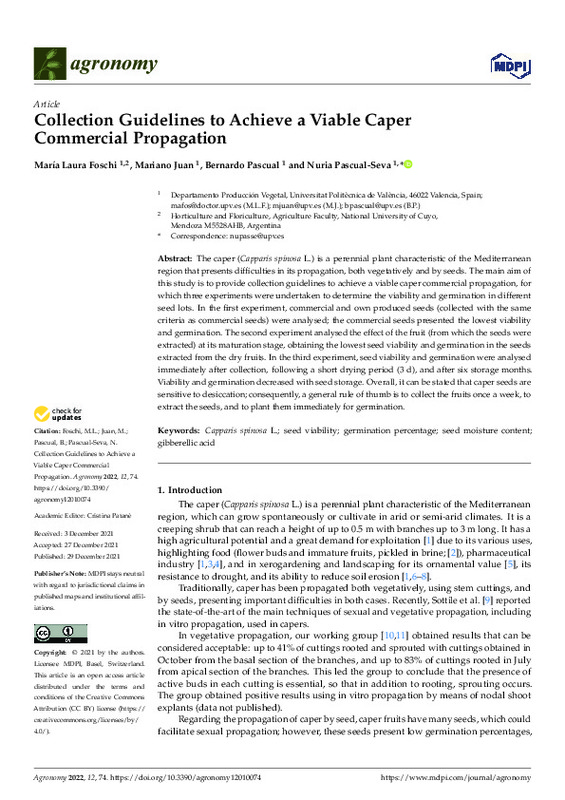JavaScript is disabled for your browser. Some features of this site may not work without it.
Buscar en RiuNet
Listar
Mi cuenta
Estadísticas
Ayuda RiuNet
Admin. UPV
Collection Guidelines to Achieve a Viable Caper Commercial Propagation
Mostrar el registro sencillo del ítem
Ficheros en el ítem
| dc.contributor.author | Foschi, María Laura
|
es_ES |
| dc.contributor.author | Juan Ferrer, Mariano
|
es_ES |
| dc.contributor.author | Pascual España, Bernardo
|
es_ES |
| dc.contributor.author | Pascual-Seva, Nuria
|
es_ES |
| dc.date.accessioned | 2022-02-03T19:04:55Z | |
| dc.date.available | 2022-02-03T19:04:55Z | |
| dc.date.issued | 2021-12-29 | es_ES |
| dc.identifier.uri | http://hdl.handle.net/10251/180482 | |
| dc.description.abstract | [EN] The caper (Capparis spinosa L.) is a perennial plant characteristic of the Mediterranean region that presents difficulties in its propagation, both vegetatively and by seeds. The main aim of this study is to provide collection guidelines to achieve a viable caper commercial propagation, for which three experiments were undertaken to determine the viability and germination in different seed lots. In the first experiment, commercial and own produced seeds (collected with the same criteria as commercial seeds) were analysed; the commercial seeds presented the lowest viability and germination. The second experiment analysed the effect of the fruit (from which the seeds were extracted) at its maturation stage, obtaining the lowest seed viability and germination in the seeds extracted from the dry fruits. In the third experiment, seed viability and germination were analysed immediately after collection, following a short drying period (3 d), and after six storage months. Viability and germination decreased with seed storage. Overall, it can be stated that caper seeds are sensitive to desiccation; consequently, a general rule of thumb is to collect the ruits once a week, to extract the seeds, and to plant them immediately for germination. | es_ES |
| dc.language | Inglés | es_ES |
| dc.publisher | MDPI | es_ES |
| dc.relation.ispartof | Agronomy | es_ES |
| dc.rights | Reconocimiento (by) | es_ES |
| dc.subject | Capparis spinosa L. | es_ES |
| dc.subject | Seed viability | es_ES |
| dc.subject | Germination percentage | es_ES |
| dc.subject | Seed moisture content | es_ES |
| dc.subject | Gibberellic acid | es_ES |
| dc.subject.classification | PRODUCCION VEGETAL | es_ES |
| dc.title | Collection Guidelines to Achieve a Viable Caper Commercial Propagation | es_ES |
| dc.type | Artículo | es_ES |
| dc.identifier.doi | 10.3390/agronomy12010074 | es_ES |
| dc.rights.accessRights | Abierto | es_ES |
| dc.contributor.affiliation | Universitat Politècnica de València. Departamento de Producción Vegetal - Departament de Producció Vegetal | es_ES |
| dc.description.bibliographicCitation | Foschi, ML.; Juan Ferrer, M.; Pascual España, B.; Pascual-Seva, N. (2021). Collection Guidelines to Achieve a Viable Caper Commercial Propagation. Agronomy. 12(74):1-14. https://doi.org/10.3390/agronomy12010074 | es_ES |
| dc.description.accrualMethod | S | es_ES |
| dc.relation.publisherversion | https://doi.org/10.3390/agronomy12010074 | es_ES |
| dc.description.upvformatpinicio | 1 | es_ES |
| dc.description.upvformatpfin | 14 | es_ES |
| dc.type.version | info:eu-repo/semantics/publishedVersion | es_ES |
| dc.description.volume | 12 | es_ES |
| dc.description.issue | 74 | es_ES |
| dc.identifier.eissn | 2073-4395 | es_ES |
| dc.relation.pasarela | S\453386 | es_ES |
| dc.contributor.funder | Universitat Politècnica de València | es_ES |
| dc.subject.ods | 15.- Proteger, restaurar y promover la utilización sostenible de los ecosistemas terrestres, gestionar de manera sostenible los bosques, combatir la desertificación y detener y revertir la degradación de la tierra, y frenar la pérdida de diversidad biológica | es_ES |
| upv.costeAPC | 1262,4 | es_ES |








